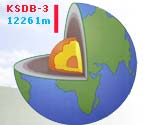Project Title: Geodynamics in the cross-section of the Kola Superdeep Title: Geodynamics in the cross-section of the Kola superdeep: structure, properties, paleo- and modern stresses of crystalline substance down to 12,261 m depth  The Kola Superdeep Borehole (KSDB-3) near Zapolyarny is the deepest borehole in the world (12,261 m deep) and a treasure for the Earth sciences. Results from investigations of KSDB-3 have drastically changed our perceptions regarding the composition and structure of the upper continental crust and the nature of seismic boundaries in it. The Kola Superdeep Borehole (KSDB-3) near Zapolyarny is the deepest borehole in the world (12,261 m deep) and a treasure for the Earth sciences. Results from investigations of KSDB-3 have drastically changed our perceptions regarding the composition and structure of the upper continental crust and the nature of seismic boundaries in it.
There is a unique opportunity to set up a model that would adequately reflect the genuine Archean, Proterozoic and modern geodynamics, structure, composition and properties of crystalline substances quasi in situ down to a depth of 12,261 m, constituting the granitic-metamorphic layer of the EarthÆs crust in the Lower Precambrian part of the Baltic Shield. The proposed Project "Geodynamics in the cross-section of the Kola superdeep: structure, properties, paleo- and modern stresses of crystalline substance down to 12,261 m" is aimed at giving answers to questions that have not been adequately studied before. The Kola Superdeep Borehole (KSDB-3) near Zapolyarny is the deepest borehole in the world (12,261 m deep) and a treasure for the Earth sciences. Results from investigations of KSDB-3 have drastically changed our perceptions regarding the composition and structure of the upper continental crust and the nature of seismic boundaries in it. There is a unique opportunity to set up a model that would adequately reflect the genuine Archean, Proterozoic and modern geodynamics, structure, composition and properties of crystalline substances quasi in situ down to a depth of 12,261 m, constituting the granitic-metamorphic layer of the EarthÆs crust in the Lower Precambrian part of the Baltic Shield. The proposed Project "Geodynamics in the cross-section of the Kola superdeep: structure, properties, paleo- and modern stresses of crystalline substance down to 12,261 m" is aimed at giving answers to questions that have not been adequately studied before. The main tasks of the Project envisage determining such physical parameters as elasticity, elastic anisotropy under in situ conditions, microfracturing, permeability, porosity etc. It is supposed to investigate relationships between seismic velocities and elasticity, elastic anisotropy, structure and changes in composition of rocks in situ. In conjunction with the lithologic column, penetrated by KSDB-3, the experimentally determined data will be used to construct models for the velocity and density structure of the middle crust. The geological, geophysical and petrophysical data obtained in four shafts of KSDB-3 will be used for structural 3-D modelling. It is planned to investigate the response of the water column in KSDB-3 to earth tidal (and possibly tectonic) forces, to barometric loading, to the passage of seismic wave fields. Geoacoustic noise will be investigated along the KSDB-3 section. It is planned to provide data on the thermal history of the KSDB-3 section, to draw conclusions about the vertical variation of heat producing elements, their mineralogy and mobility. Particular attention should be paid to setting up models of geomechanical conditions, fields of modern and paleostresses in the borehole, investigating their change from the surface to the deepest point of 12.261 km. An assessment of the current stresses will be made by analysing core disking, the borehole axis inclination, caverns orientations in the borehole shafts, etc. The importance of the proposed Project is that an international team of experts will investigate the unique object represented by the Kola Superdeep Borehole with the help of top-standard laboratory techniques and present the results of the scientific study to the world-wide audience. In addition to solution of scientific problems it is expected to obtain some social benefit. The wealth of information that will be obtained during the work on the Project will be used to improve our knowledge in (a) geomechanical stability of the continental crust; (b) potential and risks for waste disposal at great depth. Further problems to be addressed are the geological interpretation of geophysical measurements and the use of geothermal energy. The scientific and technical results that will be obtained at KSDB-3 are of global importance and as anticipated benefit, they have to be well known to scholars and specialists in earth sciences. This project includes: | 


